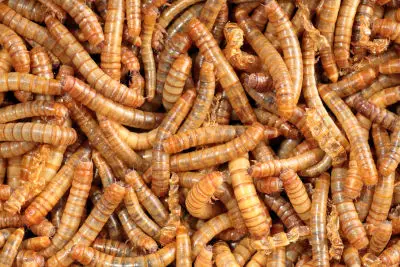Do Lizards Die When They Lose Their Tails? (Rumors?)
If you are researching lizard tails, or curious, you may wonder if they die after losing them…
Do lizards die when they lose their tails?
Lizards are unlikely to die if they lose their tail. This is because many of them can simply re-grow the tail once it is removed. In fact, this is a cunning tactic often used to avoid being killed by one of their predators. For those that can, the tail grows back. But, it will never be the same as before.
| Are these foods dangerous for your Beardie? | |
| Avacado? Click here to learn, from this guide, if this food is dangerous |  |
| Superworms? Click here to learn, from this guide, if this food is dangerous |  |
So, now you know. But, can all lizards grow back their tail? Do lizards bleed when the tail comes off? How many times can a lizard grow it back? Keep reading for these answers, and much more…
Can all lizards regrow their tails?
Not all lizards will regrow their tails. Many assume all can but this is not correct. For example, Bearded Dragons are one breed that is known to regrow their tails. But, others, like the Crested Gecko will not grow it back. However, just because they cannot grow it back, this does not mean they will die from it.
Many people assume any lizard will just regrow their tail, this is a common rumor. And, it makes sense because some can. But, even for those that can, it’s not as simple as you may think. Once it regrows it’s not instant and it will never return the same.
Regarding crested geckos growing their tails back, owners need to be very careful when handling them, cage them separately instead of in pairs or groups, and try not to expose them to loud noises or any other forms of stress to avoid scaring them into “dropping” their tails, because if it happens, you will be left with a permanently tailless lizard.
What lizards can grow their tails back?
Many lizards can grow their tale back, for example…
- Bearded Dragons
- Green Anoles
- Green Iguanas
This is not the entire list, just an example. Each of these examples will regrow their tails back at different rates, for example, it could be as quick as a few months, or as long as a year.
Do lizards bleed when their tails fall off?
Lizards do bleed when they drop their tails. This could be small traces of blood before it heals or some flesh exposed. However, for those that can regrow it, it is quickly healed and the process to replace it starts.
It would impossible to have no blood because there is a regular flow of blood there. But, their body can deal with the healing process in a very clever way.
How do lizard tails fall off?
Their tail will fall off after being attacked. Where the wound is the lizard will instinctively contract its muscle around that area to remove the tail. This is to remove this liability, allow them to escape, and begin the healing process.
For those that can regrow the tail, it will take several months before they can expect to see the new one come through.
Does it hurt the lizard to lose its tail?
Although we can never be sure what the lizard actually feels during the tail loss process, most people seem to think they don’t feel any actual pain.
However, losing a tail can subject a lizard to considerable stress because re-growing a tail consumes considerable amounts of energy, and many lizards store their fat in their tails. Most lizards don’t act normally during the regeneration process due to the stress of re-growth and the lack of balance due to the missing tail.
Can lizards regrow their limbs?
No, lizards cannot regrow lost limbs or even toes.
What is a lizard’s tail made out of?
A lizard’s tail is an extension of its spine. The basic structure of the tail consists of a series of small bones called vertebrae that surround and protect the spinal cord. The tail can bend in many different ways because of the joints between each of the vertebrae.
The bulk of the tail is composed of muscles that act to move the tail to balance the lizard as it runs and climbs.
Some lizards use their tails as defensive or offensive weapons, rather like a whip. Some species of lizards, such as leopard geckos, also store fairly large amounts of fat in their tails that act as an energy reserve when food is scarce; a gecko with a good store of fat in its tail can survive for up to 100 days without eating.
When it grows back, is it the same as the original?
Unfortunately, the new tail is often very different from the original tail. It may be shorter, thinner, and/or be a different color. However, the real differences can’t be seen because they are inside the tail. Unlike the original tail, which is composed of multiple bones, muscles, and skin, the new tail is made out of long tubes of cartilage instead of bone and abnormally long muscles stretching the length of the tail.
The re-growth process starts with a stub growing out of the lizard’s remaining tail and gradually elongates to form the new tail. Sometimes the change in color from the original can be startling. However, the new tail can be moved just like the original tail and functions like a normal tail. In some cases, the tail regeneration process does not work properly and strange things happen, like an abnormally shaped lump or multiple tails forming.
Do all species have this ability?
Most but not all lizards can drop their tails, and some species that can drop their tails do not regrow them, like the crested gecko. The various types of monitor lizards, which tend to be large, carnivorous, and use their tails as weapons, cannot drop their tails, and if their tail is accidentally severed it will not grow back.
Why do lizards drop their tails?
How can you prevent your lizard from dropping its tail?
Lizard owners can usually prevent tail-shedding by reducing the stress to their lizard, by being careful to not scare it during handling, and by slowly and carefully taming the lizard so that handling is not upsetting to the lizard.
Also, lizards kept in pairs or groups may fight and end up shedding their tails, so if you observe any signs of conflict between your lizards it may be best to house them separately.
After-care for lizards that dropped their tail
If your lizard does drop its tail, it is important to make sure the lizard has plenty of highly nutritious food and optimal housing conditions to speed the healing process and watch in fascination as the lizard regrows its tail (Click here to see the lizard that bites its own tail, and why?). I hope you enjoyed reading this article and find the presented information very useful in caring for your lizard.